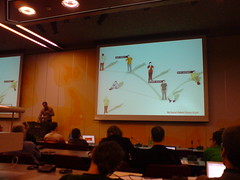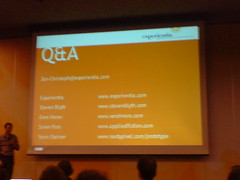LIFT07: Jumping Jack Flash, Jan-Christoph Zoels of Experientia
LIFT07: Jumping Jack Flash: new forms of interaction, Jan-Christoph Zoels of Experientia
What would be the mobile equivalent of someone tugging your arm to get attention? Would you like to take over your friends phone? How can a child leech time from its parents account when it runs out of credit?
 2 concept projects for Nokia's Innovation and Foresight group: new devices for mobile device ownership and exchange of content.
2 concept projects for Nokia's Innovation and Foresight group: new devices for mobile device ownership and exchange of content.
1. Dominant games: nice video of a little girl playing a game, she runs out of time, and her mother allocates her some of her airtime so she can continue playing on. 2 hours later her mother notices that she's overrun her credit and stops her daughter playing.
Right now 6-8 year old children are the fasted growing market segment of mobile phone users. What apps let kids to participate, whilst parents can keep a level of control?
2. Friendly intrusion ("make yourself heard"): invade your buddies desktop for just a second. Marco needs to know Angie's phone number so he sends a message to 3 friends, interrupting them all.
Our attitudes to mobile use are changing. Right now a message from a friend pops up an icon on your screen: what if you could do more, dominating your friends screens?
"Design predicts the future when it anticipates experiences" - Augusto Morello
Move from usability to focusing on delight, from usability to playability.
Person-to-screen interactions, person-to-device interactions (e.g. Wii), person-to-responsive spaces interactions, interactive architecture, person-to-person interactions.
 "My Social Fabric" by Steven Blyth: your social world on your mobile. Not replacing the address book, but keeps you subtly informed about prospering or neglected relationships. Lets you cluster your contacts into groups, the gestures of doing this is a form of "body language". Creates a sense that opportunity to act within a respectable window is finite: your contacts turn their back on you if you don't call them for ages.
"My Social Fabric" by Steven Blyth: your social world on your mobile. Not replacing the address book, but keeps you subtly informed about prospering or neglected relationships. Lets you cluster your contacts into groups, the gestures of doing this is a form of "body language". Creates a sense that opportunity to act within a respectable window is finite: your contacts turn their back on you if you don't call them for ages.
Oren Horev: "Talking to the hand", how shape-shifting objects suggest new narratives; tactile status updates.
"Phony Star" by Soren Pors: part of a fast concept development in 2 weeks: first week work up the concept, second week prototype. Lovely video of a couple miming a cheesy song karaoke-style over video calling.
Exploring responsive spaces: Dario Buzzini, "Not-So-White-Walls", with an interactive wall-space that can change itself. In this example, the wall displays a message received on a mobile.
Gestural interactions: Smart Retina, Mossa Libre and Artissima but Yanniv Steiner, Riccardo Strobbia and Jan-Christoph Zoels.
Smart retina: a box detects hand movements and gestures to interact with Google Earth. Fairly simple, translates hand shapes ("zoom", "stop", "rotate") into commands.
 This used to be done with expensive equipment, not can be prototyped with Flash (tho presumably there's still hardware).
This used to be done with expensive equipment, not can be prototyped with Flash (tho presumably there's still hardware).
A lot of this stuff isn't necessarily practical, but it points the way to new forms of interaction.
Q: Where do you get the gestures?
A: In Italy there are 30-50 gestures used in everyday life.
Q: (Adam Greenfield) Have you given thought to standardising a library of gestures?
A: What is the interaction design language of gestures? Part of it will be contextual and culturally based. I don't favour a totalitarian approach; these playful learning applications are good for encouraging mistakes.